

Order: Opiliones, Harvestmen
There are seven pages, this page with general information and four pages with the species. Furthermore two pages with foreign sightings during holidays:
General information
Harvestmen are not toxic.
Harvestmen are often called spiders but they are a separate order. Harvestmen have no possibility to spin a web, they can't produce silk. What also is missing are the venom glands that spiders do have. The story that the harvestmen are very toxic is consequently not true. To defend themselves they can release a smelly liquid.

Harvestmen have no venom glands and are non-toxic
Food

Rilaena triangularis, juvenile, eats a springtail
Harvestmen are generally omnivores.
So they eat both vegetable and animal food, although there are species that only eat animal-based feeds.
Often it are scavengers and they live further from decaying plants, small invertebrates etc.
They reduce their food with the shears that are on the chelicerae.
Below on the picture of a dead male D. ramosus that I've found in a spider's web you can clearly
see how this looks like. It are a kind of lobsters scissors.
It consists of three parts, the first part is pointing forward, the second downward and forms with the third
the scissors. I have laid down the dead animal on its back, so you can see the scissors well.
Often the chelicerae are increased on the males. A good
example is the male Phalangium opilio, which you can recognize
at a great distance at the great chelicerae.
In addition to the cheliceren there are the pedipalps, on the picture they put forward and walk out of view.
In the Dicranopalpus ramosus the pedipalps are forked, on which you can identify the species. Often are they differed
in male and female, in D. ramosus the male has thin pedipalps, the female pedipalps are thick and hairy.
Further you see on both sides the four walking legs, i.e. the attachments, because this animal misses a number of legs.

strekpoot, Dicranopalpus ramosus ♂
Molting
Like all other arthropods the harvestmen have to shed their skin. After several times they are adult and then stop molting. For molting they hang somewhere and crawl out of their old skin, such as the harvestman on the photo. Normally the harvestmen has a lot (8) of legs now it's a bunch, eight legs from the newly shed animal and eight of the old skin. You often find empty skins under the hollow side of pieces bark that lay on the ground.

Dicranopalpus ramosus
Reproduction
Harvestmen life generally a year and reproduction goes through eggs. Internal fertilization takes place, at the mating are the animals facing each other. The females put the eggs with a ovipositor in the ground or on damp places such as in crevices in the bark of trees. Most species come through the winter in the egg phase. On the photos below, a female Leiobunum spec A and Platybunus pinetorum with ovipositor, a male Platybunus pinetorum with visible reproductive organ and mating of Opilio saxatilis.
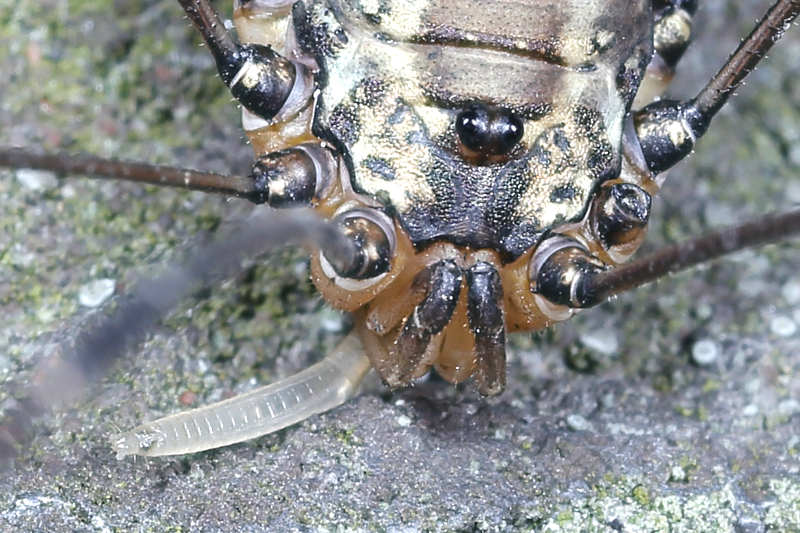
Leiobunum spec A, ovipositor visible
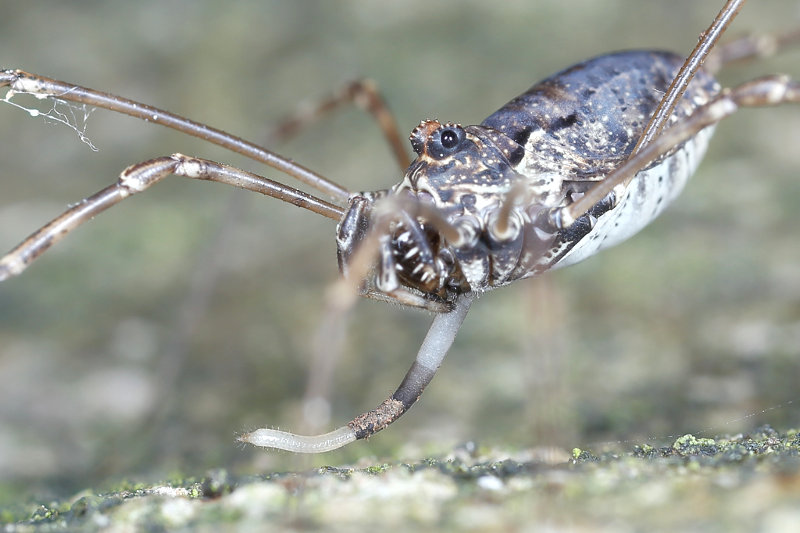
Platybunus pinetorum, ovipositor visible

Platybunus pinetorum ♂

Platybunus pinetorum ♂

Opilio saxatilis
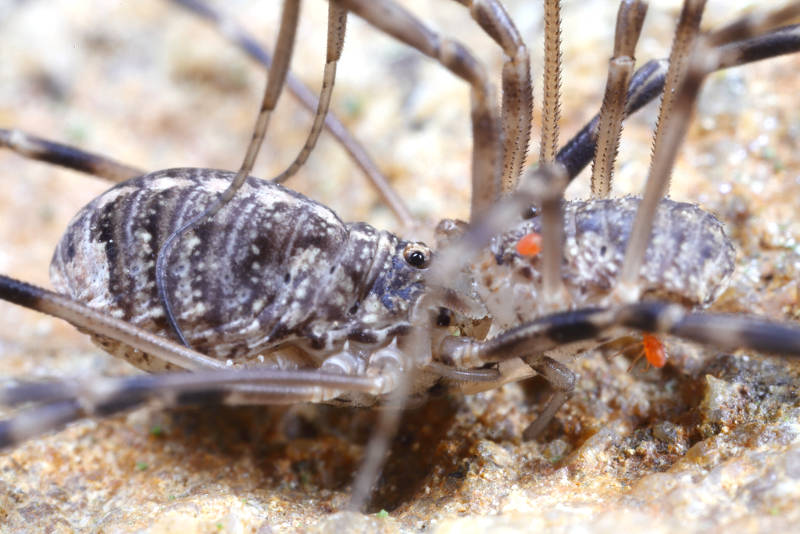
Opilio saxatilis
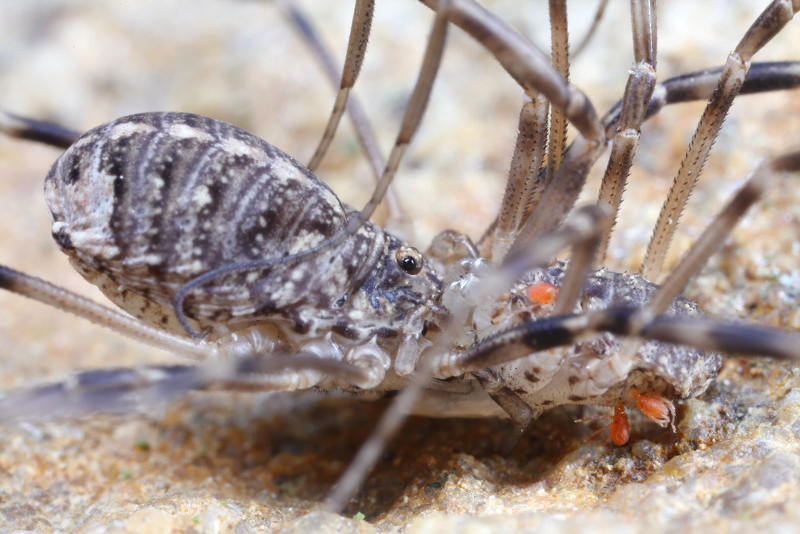
Opilio saxatilis

Opilio saxatilis
a spider and a harvestman

spider
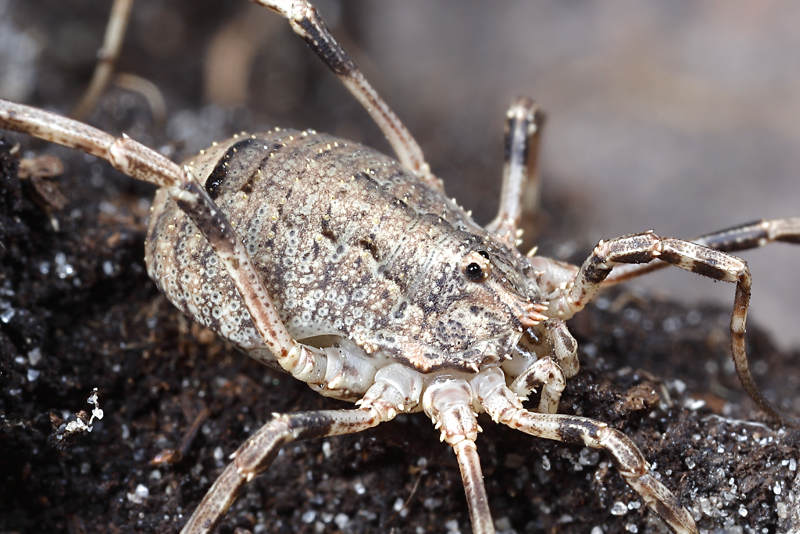
harvestman
The difference between harvestmen and spiders is that harvestmen are so on the eye a ball with legs, spiders have always two body sections, are clearly two pieces with the legs on the front part. The eyes of harvestmen lay on a hillock on top of the body, they have two eyes, spiders usually have six or eight eyes.
Daddy longlegs:
In English the Opiliones are called harvestmen or daddy longlegs. The last name is confusing because that is also used for a spider and for the craneflys.

cranefly_daddy longlegs
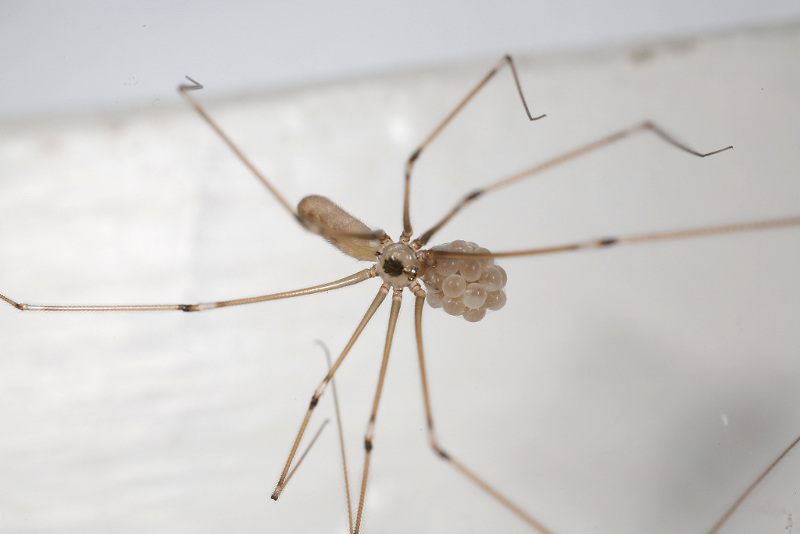
Pholcus spider_daddy longlegs

harvestman_daddy longlegs
Fungus from the group Laboulbeniales:
These fungi live on arthropods and are best known for infesting beetles. Among harvestmen, they also occur, pictured is a Dicranopalpus ramosus with an infestation around one eye.
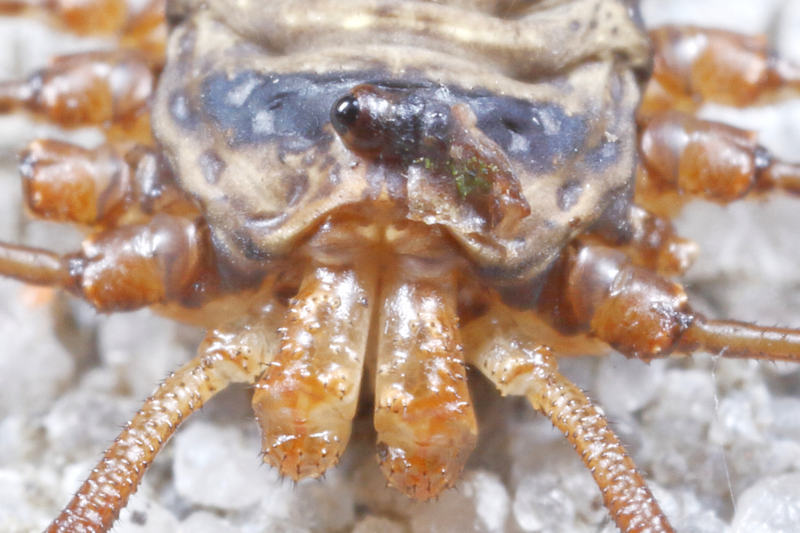
Laboulbeniales
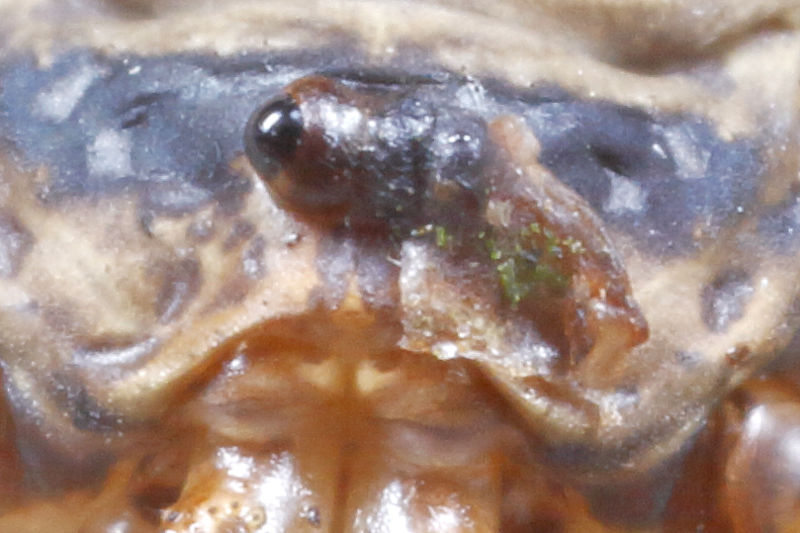
Laboulbeniales
Mites
Harvestmen often suffer from parasitic mites. On the legs but also on the body. It are the larvae of the Velvet mite, see my page diversen for photographs of the mite, sorry the text there is in Dutch.

Platybunus pinetorum with mite

Mitopus morio with mites

Mitopus morio with mites
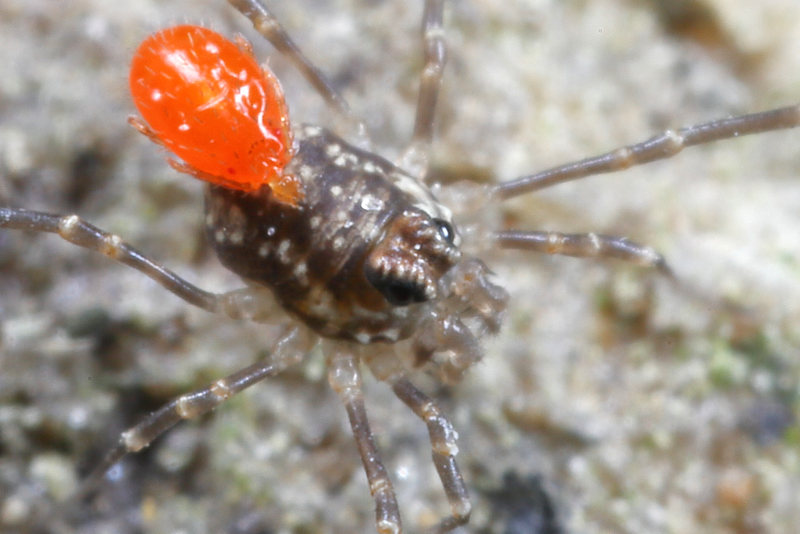
Rilaena triangularis, juvenile with mite
Pseudoschorpion
Pseudo Scorpions are very small Arachnids that live off small arthropods. In order to move over larger distances, they keep themselves sometimes stuck to the legs of large insects such as beetles and flies. Mid May 2018 several are on Platybunus pinetorum near Schoonoord. The Pseudo Scorpions use the harvestman only as a means of transport, they go hitch-hiking.

Platybunus pinetorum with Pseudoschorpions

Platybunus pinetorum with Pseudoschorpion
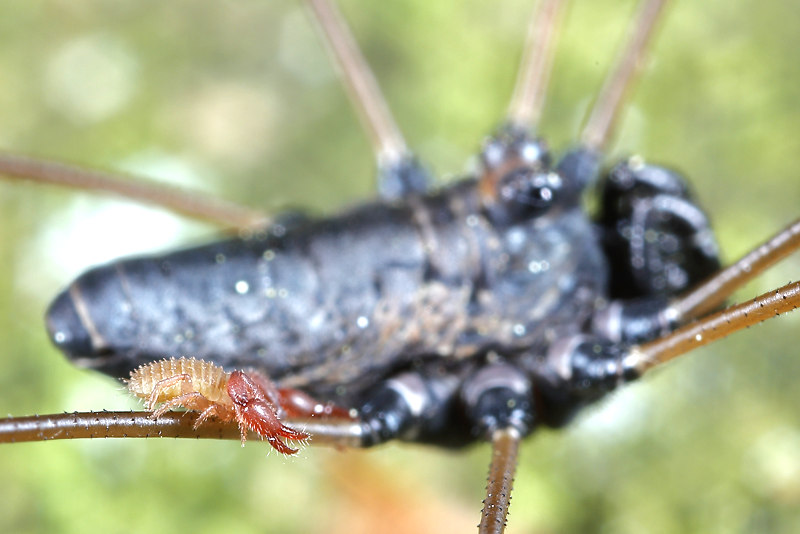
Platybunus pinetorum with Pseudoschorpion

cranefly with Pseudoschorpions
Species
In The Netherlands there are now 33 species. Worldwide approximately 7000 species.
An overview of the Dutch species from 1975 mentions 21, (Spoek 1975). pdf English.
The last years there have been 12 species introduced.
This are species from the South of
Europe and North Africa that extend to the North.
Below is a list
in order of first performance with at the back the author who described the first sighting in The Netherlands with
sometimes the possibility to download this document from the website of Naturalis.nl, natur-in-nrw.de, and eis-nederland.nl:
1991 Opilio canestrinii (Thorell, 1876) (Weele 1993)
1993 Dicranopalpus ramosus (Simon, 1909) (Cuppen 1994)
1997 Nemastoma bimaculatum (Fabricius, 1775) (Wijnhoven 1997)
1997 Trogulus nepaeformis (Scopoli, 1763) (Wijnhoven 1998ab
1998 Platybunus pinetorum (C.L. Koch, 1839) (Wijnhoven 1998ba)
2002 Leiobunum sp. A (Wijnhoven et al. 2007) (pdf)
2003 Astrobunus laevipes laevipes (Canestrini, 1872) (Wijnhoven 2003) (pdf)
2004 Nelima sempronii Szalay, 1951 (Wijnhoven 2005) (pdf)
2006 Nelima doriae (Canestrinii, 1871) (Wijnhoven 2007) (pdf)
2012 Leiobunum religiosum Simon, 1879 (Noordijk & Bink 2014) (pdf)
2014 Trogulus nepaeformis (Wijnhoven 2014)
Thanks
I would like to thank Joost Vogels, Arp Kruithof and Hay Wijnhoven for the enormous amount of information they have provided me through the forum of waarneming.nl. By this my interest in the harvestmen became strongly stimulated.
literature:
- Arthofer W, Rauch H, Thaler-Knoflach B, Moder K, Muster C, Schlick-Steiner BC, Steiner FM. How diverse is Mitopus morio? Integrative taxonomy detects cryptic species in a small-scale sample of a widespread harvestman. — Mol Ecol. 2013 Jun 4. doi: 10.1111/mec.12340. (Epub ahead of print)
- Cuppen, J.G.M. 1994. Dicranopalpus ramosus, a new species of harvestman for the Netherlands (Opilionida: Phalangiidae). — Entomologische Berichten, Amsterdam 54: 176-178.
- Martin, O.Y. & Goodacre, S.L. 2009. Widespread infections by the bacterial endosymbiont Cardinium in arachnids — 2009. The Journal of Arachnology 37:106-108
- Meijer, J. 1973. Some remarks on the systematics of the Mitostoma chrysomelas group (Arichnida, Opilionida Nemastomatidae) — Zoologische mededelingen Leiden deel 46 no 9 blz 117-127
- Noordijk, J. 2014. Laatste populaties van de hooiwagen Opilio parietinus (Opilionida: Phalangiidae) in Nederland. — Entomologische Berichten, 74(1-2). 2014: 21-27.
- Noordijk, J. & Bink, J. 2014. Leiobunum religiosum (Opiliones:Sclerosomatidae), een nieuwe hooiwagensoort voor de Nederlandse fauna. — Entomologische Berichten, 74(4). 2014: 21-27.
- Spoek, G.L. 1975. De hooiwagens (Oplionida) van Nederland. — Wetenschappelijke Mededelingen knnv 50: 1-32.
- Weele, R. van der 1993. Opilio canestrinii nieuw voor de Nederlandse fauna (Opilionida: Phalangiidae). — Entomologische Berichten, Amsterdam 53: 91.
- Wijnhoven, H. & P. Koomen 1997. Nemastoma bimaculatum in Nederland (Arachnida: Opilionida). — Nederlandse Faunistische Mededelingen 7: 5-6.
- Wijnhoven, H. 1998a. De kleine hooiwagen Nemastoma dentigerum Canestrini (Opilionida, Nemastomatidae). — Nieuwsbrief Spined 13: 1-5.
- Wijnhoven, H. 1998b. De hooiwagen Platybunus pinetorum, nieuw voor de fauna van Nederland (Opiliones: Phalangiidae). — Entomologische Berichten, Amsterdam 59: 233-237.
- Wijnhoven, H. 2005. De hooiwagen Nelima sempronii nieuw voor Nederland (Opiliones: Phalangiidae). — Nederlandse Faunistische Mededelingen 22: 1-6.
- Wijnhoven, H. 2007 de hooiwagen Nelima doriae nieuw voor nederland (arachnida: opiliones). — Nederlandse Faunistische Mededelingen 26: 69-75.
- Wijnhoven, H. Schöhofer, A.L. & Martens, J. 2007 An unidentified harvestman Leiobunum sp. alarmingly invading Europe (Arachnida: Opiliones). — Arachnol.Mitt. 34: 27-38.
- Wijnhoven, H. (2011) Notes on the biology of the unidentified invasive harvestman Leiobunum sp. (Arachnida: Opiliones). Arachnologische Mitteilungen, Vol.41, pp.17-30.
- Wijnhoven, H. & Noordijk, J. 2011 Platybunus pinetorum, een volgende hooiwagen die Nederland verovert (Opiliones: Phalangiidae) — Nederlandse Faunistische Mededelingen 36: 9-14.
- Wijnhoven, H. & Noordijk, J. & Heijerman, T. 2014 het hooiwagengenus trogulus in nederland (opiliones: trogulidae) — Nederlandse Faunistische Mededelingen 42: 1-10.
List of the Dutch species:
- family: Ischyropsalididae, 1 species in the Netherlands,
only three specimen at the end of the 1960s (Spoek,1975) - Ischyropsalis hellwigi (Panzer, 1794)
- family: Nemastomatidae, 5 species in the Netherlands
- Mitostoma chrysomelas (Hermann, 1804)
- Nemastoma bimaculatum (Fabricius, 1775)
- Nemastoma dentigerum Canestrini, 1873
- Nemastoma lugubre (Mueller, 1776)
- Paranemastoma quadripunctatum (Perty, 1833)
- family: Phalangiidae 14 species in the Netherlands
- Dicranopalpus ramosus (Simon, 1909).
- Lacinius ephippiatus (C.L. Koch, 1835).
- Lophopilio palpinalis (Herbst, 1799).
- Mitopus morio (Fabricius, 1795).
- Odiellus spinosus (Bosc, 1792).
- Oligolophus hanseni (Kraepelin, 1896).
- Oligolophus tridens (C.L. Koch, 1836).
- Opilio canestrinii (Thorell, 1876).
- Opilio parietinus (De Geer, 1778).
- Opilio saxatilis C.L.Koch 1839.
- Paroligolophus agrestis (Meade, 1855).
- Phalangium opilio Linnaeus, 1758.
- Platybunus pinetorum (C.L. Koch, 1839).
- Rilaena triangularis (Herbst, 1799).
- family: Sclerosomatidae 9 species in the Netherlands
- Astrobunus laevipes (Canestrini, 1872).
- Homalenotus quadridentatus (Cuvier, 1795).
- Leiobunum blackwalli Meade, 1861.
- Leiobunum religiosum Simon, 1879.
- Leiobunum rotundum (Latreille, 1798).
- Leiobunum spec A.
- Nelima doriae (Canestrini, 1871)
- Nelima gothica (Lohmander, 1945).
- Nelima sempronii (Szalay, 1951).
- family: Trogulidae, 4 species in the Netherlands
- Anelasmocephalus cambridgei (Westwood, 1847)
- Trogulus closanicus Avram, 1971.
- Trogulus nepaeformis (Scopoli 1763)
- Trogulus tricarinatus (Linnaeus, 1758).